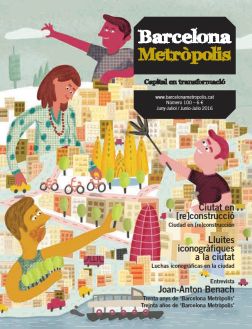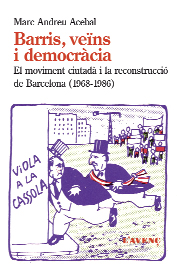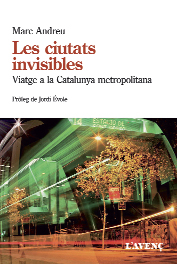Barris, veïns i democràcia. El moviment ciutadà i la reconstrucció de Barcelona (1968-1986)
(Neighbourhoods, Residents and Democracy. The Citizens’ Movement and the Rebuilding of Barcelona – 1968-1986)
Author: Marc Andreu
Els Llibres de L’Avenç
Barcelona, 2015
512 pages
Les ciutats invisibles. Viatge a la Catalunya metropolitana (Invisible Cities. Journey to Metropolitan Catalonia)
Author: Marc Andreu
Els Llibres de L’Avenç
Barcelona, 2016
200 pages
Two recent books by journalist and historian Marc Andreu, published by Els Llibres de L’Avenç, offer a realistic view of the reality of Catalan cities in the second half of the 20th century and early 21st century.
The first of these books is Barris, veïns i democràcia. El moviment ciutadà i la reconstrucció de Barcelona (1968-1986). This book, written from thesis work done by the author, offers a detailed analysis of the “citizens’ movement forged in neighbourhoods during the dictatorship”, which was in turn “a prominent component of the struggle against Franco that made possible the transition to democracy and the defence of the interests of the lower classes during the process of political and institutional change.”
The other book, Les ciutats invisibles. Viatge a la Catalunya metropolitana, is a collection of articles published by the author in the magazine L’Avenç between the autumns of 2014 and 2015. It borrows its title in part from Invisible Cities by Italo Calvino. Like the great Khan, who knew little about his cities, Marc Andreu’s book is about Catalans who are unaware of the reality of their cities because “many districts and metropolitan areas in today’s Catalonia are invisible cities inhabited by thousands and thousands of people” to whom “the mass media […] pay precious little attention” (Les ciutats…, p. 187).
Both books are about neighbourhoods, understood as the parts of the city that inhabitants directly experience as places of residence, access points for basic services and the cradle of everyday social life. As Jordi Évole wrote in the prologue to Les ciutats invisibles, “that was where I had my school, my makeshift football pitch […], my grandfather, my grandmother, my junkies, my neighbours, my square, my friends… That’s where it all was” (Les ciutats…, p. 12).
The protagonists of Barris, veïns i democràcia are residents of Barcelona’s neighbourhoods who, during the transition to democracy, organised a powerful movement that demanded urban planning policies in benefit to ordinary citizens and not speculators. They also demanded a democratic management of the city and achieved highly tangible success in the field of urban planning. They were a source of inspiration across Spain and influenced the dynamics of the transition to democracy. The Spanish State responded to pressure from neighbourhood associations with concessions. However, they also repressed them by stripping them of constitutional protection, by supporting violence perpetrated against them by neo-Nazi “ultra” groups and by delaying municipal elections. These measures were a reaction to fear of their “ideas of direct democracy”, a stance which was shared by the Spanish Socialist (PSOE) and Union of the Democratic Centre (UCD) political parties (p. 387).
It is thus not at all strange that Barcelona City Council under socialist hegemony has, since 1979 (first with support from the Unified Socialist Party of Catalonia [PSUC] and later from the Initiative for Catalonia Greens [ICV]), opposed the participation of residents in city meetings and rejected a profound transformation of the city’s social structure. Similarly, according to the author, the Olympic initiative served to transform the “Barcelona model” of redistributive and relatively participatory urban planning into a “simple Barcelona brand” (p. 434).
An analysis of recent developments shows similarities with the second book – quite different from the first in form, but not so much in terms of substance. Indeed, Les ciutats invisibles, a narration of the author’s journey through Catalan metropolitan neighbourhoods, offers a useful explanation of a reality too far removed from the political agendas of governments and mass media. The journey itself, however, is not told as a literary narrative. It rather uses a literary pretext to put forth pertinent issues and theoretical concerns: living conditions, the social and ethnic makeup of districts, the spoken languages, feelings of identity, the capacity (whether big or small) for social mobilisation, the contrast between some of the city’s macro-projects and daily life in the neighbourhoods.
The two books together most definitely comprise a single academic and political project: establishing the historical and present existence of realities that are more invisible than they should be: that of “popular” Catalan societal sectors (p. 83) which should, in the words of Xavier Domenech (cited by the author) be “more realistically portrayed”.
Both books undoubtedly contribute to this portrayal, and while Barris, veïns i democràcia should become a basic reference work on the history of social movements in Catalonia, Les ciutats invisibles should contribute, as desired by its author, to a revival of the “social and urban chronicle” as a journalistic genre (El País, 02/06/2016). And as both books are part of the same academic and political project originating from a very specific political sensibility, they share a weakness: the tendency to idealise neighbourhoods (or a lack of concern about accurately representing the Federation of Residents’ Associations of Barcelona [FAVB] and its member associations, with the idea that they are more “real” than other realities that also exist: “the neighbourhood is where the best stories are” says Évole) and a decontextualisation from the global economy.
And, in a very nuanced (as academic tradition dictates) book, and in a clearer way than the other one, he puts forth a body of discourse about the districts that is profoundly political. That is, a specific way of understanding what metropolitan districts are all about that coincides with the author’s partisan leanings. This is borne out by: his choice of neighbourhoods (of the ten poorest municipalities in the Barcelona metropolitan area, the author chooses seven and in the process leaves out Sant Vicenç dels Horts as well as the nineteen most “well-off” districts); his mistrust of international economic initiatives; the conflict between the right to choose and the right to exist (nuanced in the author’s work but forceful in the prologue by Évole); and a lack of clear economic alternatives to the model that is rejected.
But the author is right when he says that “invisible cities and the heartbeat within them” have become “more and more” difficult to ignore (p. 187). Nonetheless, this notion definitely cannot be said to have a single political interpretation, or social basis, as evidenced by the fact that many of the charitable initiatives that emerge do so in middle-class districts. And, as Toni Soler wrote in the newspaper Ara (25/05/2015), there is more than one “process” at work in Catalonia. Each of them with their own myths and idealisations in opposition to those of the state (or those of economic liberalism), and with partnerships that transcend academic logic.





